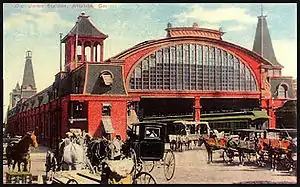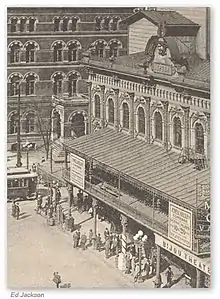Maximilien van den Corput | |
|---|---|
 Max van den Corput | |
| Born | September 24, 1824, Elsene (Ixelles), Belgium. near Brussels, Belgium |
| Died | January 16, 1911 Atlanta, Georgia, US |
| Place of burial | |
| Allegiance | |
| Service/ | |
| Years of service | 1861–1865 |
| Rank | |
| Commands held | Cherokee Artillery |
| Battles/wars | American Civil War |
| Spouse(s) | Marie Roberts van den Corput |
| Other work | architect, engineer |
Max Corput, fully documented as Maximilien van den Corput (died 1911) was a Belgian-American architect. He designed the second Union Station in Atlanta, Georgia.[1] Van den Corput also served as an officer in the Confederate States Army during the American Civil War.

Name
The "van den" (Dutch: from the) is very common in Dutch and Belgian surnames, and references to Corput regarding the civil war usually include his full last name. However, later references including one in the Atlanta Constitution omit the "van den", suggesting that he later went simply by "Corput".[2] His first name has, in additionally to alternative spelling, also been documented as "Maxwell" and occasionally "Joseph John" as middle names.
Early life and civil war
Corput was born near Brussels in Belgium. His exact date of birth is unknown, and has variously been put between 1824 and 1826. In 1848 he belonged to a group of Belgians who emigrated to the United States after the incorporation of Belgium into the United Kingdom of the Netherlands, which caused dissatisfaction among the French-speaking Belgian elite.[3] The group, that included several family members like Corputs younger brother Felix, traveled via New York and Charleston. As the Cherokee Indians had recently been dispossessed of Northwest Georgia, freeing the land for further settlement, the Corputs settled as farmers in the area at Cave Spring.[4]
When the Civil War started in 1861 Corput joined the Confederate States Army. He was commissioned as a Third Lieutenant (1861)[5] in the Cherokee Artillery battery; a unit recruited from the Floyd and Cherokee counties. Several of his relatives joined the unit, too, his brother Felix being the Quartermaster Sergeant. The unit was surrendered during the Siege of Vicksburg, but quickly returned to the field afterwards. By 1864 Corput had been promoted to captain and commanded the battery. At the Battle of Resaca its four 12-pounder Napoleons were captured.[6][7][8] Corput himself became a prisoner of war on April 12, 1865 at Salisbury, North Carolina. He was held prisoner at Camp Chase, Ohio until paroled in October.[4]
Later life
After the war Corput settled in Atlanta and founded the architectural firm of Van den Corput and Fay. He had previously been involved in the firm Corput and Bass, where he had begun his career as an engineer, but became known for his architectural designs.

Corput died on January 16, 1911, in Atlanta and was buried there in Oakland Cemetery. His grave was unmarked until 2014. His wife, and mother of their six children, Marie, was 24 years younger than him and died in 1920.[9] Corput and his battery are the namesakes of the Sons of Confederate Veterans Capt. Max van den Corput's Battery Camp #669.[4]
Buildings designed
- Georgia Railroad Freight Depot (1869), the oldest building in Downtown Atlanta
- DeGive's Opera House (1870–1921)
- Atlanta's second Union Station (1871–1930)
- The Clayton County Courthouse
- The Old Bartow County Courthouse
References
- ↑ Wilber W. Caldwell, The courthouse and the depot: the architecture of hope in an age of despair, p.279
- ↑ "Major Corput", Atlanta Constitution, April 23, 1869
- ↑ George Magruder Battey, A History of Rome and Floyd County, pp.355-6
- 1 2 3 Upthegrove, Larry (October 31, 2014). "Oakland Resident Spotlight: Maximilien van den Corput". Historic Oakland Foundation. Retrieved 17 March 2016.
- ↑ George Magruder Battey, A History of Rome and Floyd County, p.365
- ↑ "May 15", Friends of Battle of Resaca
- ↑ "Battle of Resaca", New Georgia Encyclopedia
- ↑ "Resaca... now is time", Rome News-Tribune, January 12, 2007, p.3
- ↑ Obituary, Atlanta Constitution, October 23, 1920